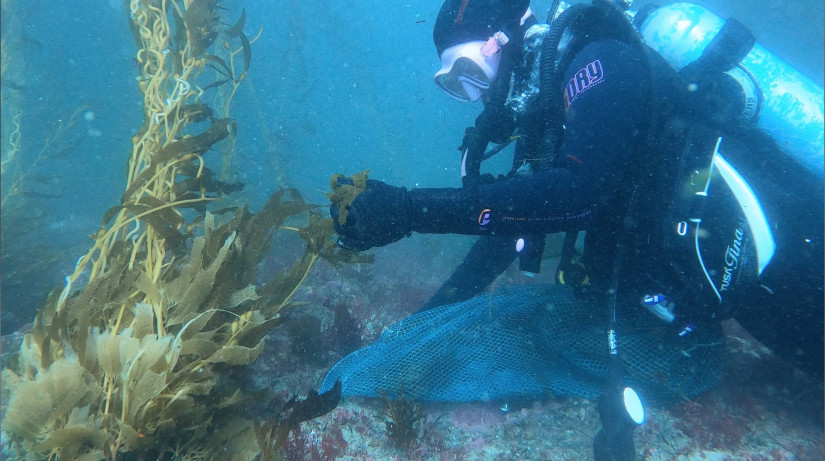Giant kelp forms towering underwater forests that support the wealth of marine life along California’s shores. But these forests are under serious threat from warming waters and the cascading effects of disturbance, leading a team of researchers to test new methods for reforesting the undersea landscape.

Led by Joleah Lamb and Matthew Bracken, both of U.C. Irvine, the project is part of the Kelp Recovery Research Program funded by California Sea Grant and the California Ocean Protection Council, in collaboration with the California Department of Fish and Wildlife. It is also part of a large coalition of scientists around the world working to restore kelp forests. Following preliminary success with a related kelp species in Norway, Lamb’s team is using a new technique dubbed Green Gravel. It’s a fancy term for a piece of regular gravel about the size of a marble, which is seeded with young kelp spores in the lab.
The technique’s strongest appeal is that, once seeded, the gravel can be spread from a boat, simply tossed overboard like wildflower seeds in a meadow. This would greatly reduce the cost and effort necessary for reforesting kelp beds, eliminating the need for highly trained scientific divers.
Overcoming early challenges

Before reaching that end goal, however, the research team has to do the heavy lifting- troubleshooting how to get young kelp to grow on gravel in a lab environment. When working with the primordial soup of seawater, this isn’t an easy task. The crew struggled with diatom contamination issues, prompting graduate researchers Phoebe Dawkins and Andrea Paz-Lacavex, along with research specialist Evan Fiorenza, to develop an entirely new incubator system for the growing kelp. They scaled down from one massive aquarium to an incubator the size of a refrigerator filled with neatly stacked jars of gravel, each one filled with seawater and seeded with kelp.
And contamination isn’t the only challenge. California’s waters are rougher than Norway’s, and there is concern that the gravel could get tossed and carried away by strong ocean currents. This would make it difficult to monitor the success of reforestation in the field. Not a team to be deterred by a challenge, they added an additional method to their experiment in the form of small terracotta tiles: these can be secured to the reef and returned to by divers to monitor kelp growth rates.
Future-proofing kelp forests
In order to seed the gravel and tiles in the lab, the researchers visit kelp forests offshore and collect spores. This adds another dimension to the research, giving them the ability to source from different populations along the California coast. Giant Kelp, Macrocystis pyrifera, is found from southeast Alaska to Baja California, Mexico. Right now, they are growing spores collected from different parts: the northern, cold waters off Santa Cruz and the warmer, southern waters of San Diego.

Kelp grown from both populations will be deployed offshore of San Diego, giving insight into how individuals from the Santa Cruz population, which are adapted to cooler temperatures, will fare.
“I think this is one of the first kelp projects to allow the translocation of different populations,” says Lamb.
Using kelp from different populations could help predict how genetic diversity will contribute to the resiliency of giant kelp as the ocean warms with climate change. If there are populations that are found to be particularly adaptive to heat stress, then these can be used in reforestation projects to “future proof” the restoration site.
Next steps
Testing the gravel and tiles in the sea is the next step.
“We're still trying to figure out the best way to grow them, and we're very close to deployment. Hopefully in the next couple of weeks,” says Lamb.
It isn’t yet known whether this could be affected by the October 2021 oil spill off southern California’s coast, which could bring even more questions to the research design.
“We are starting to think about experiments where we have oil and non-oil concentrations at varying levels to see how it affects the spores in the environment and possibly the success of kelp in the field,” Lamb says.
Collaboration for conservation

Working with a supportive group of international researchers has been key to the project’s success. As part of the Green Gravel Action Group, the researchers are collaborating with scientists across 7 countries who share the goal of reforesting dwindling kelp forests.
Paz-Lacavex is doing her graduate research with the team and preparing to deploy the reforestation method in the waters of Baja California, the southern reach of giant kelp. With support from the Nature Conservancy, she’ll be continuing her work for the Management of Ecosystems Across the Californias (MexCal) to support coastal management and fishing communities. Lamb stressed the importance of having this ecosystem of partnerships.
“One of the great things that's happened through this collaboration is connecting with other groups trialing green gravel on other species like the bull kelp, and connecting with people like (fellow California Sea Grant grantee) Jennifer Caselle who is working on the modeling and the dynamics of the system. The more information we can get about the system and what's driving the decline, the more we can incorporate that into our experiments.”
About California Sea Grant
NOAA’s California Sea Grant College Program funds marine research, education and outreach throughout California. Headquartered at Scripps Institution of Oceanography at the University of California San Diego, California Sea Grant is one of 34 Sea Grant programs in the National Oceanic and Atmospheric Administration (NOAA), U.S. Department of Commerce.